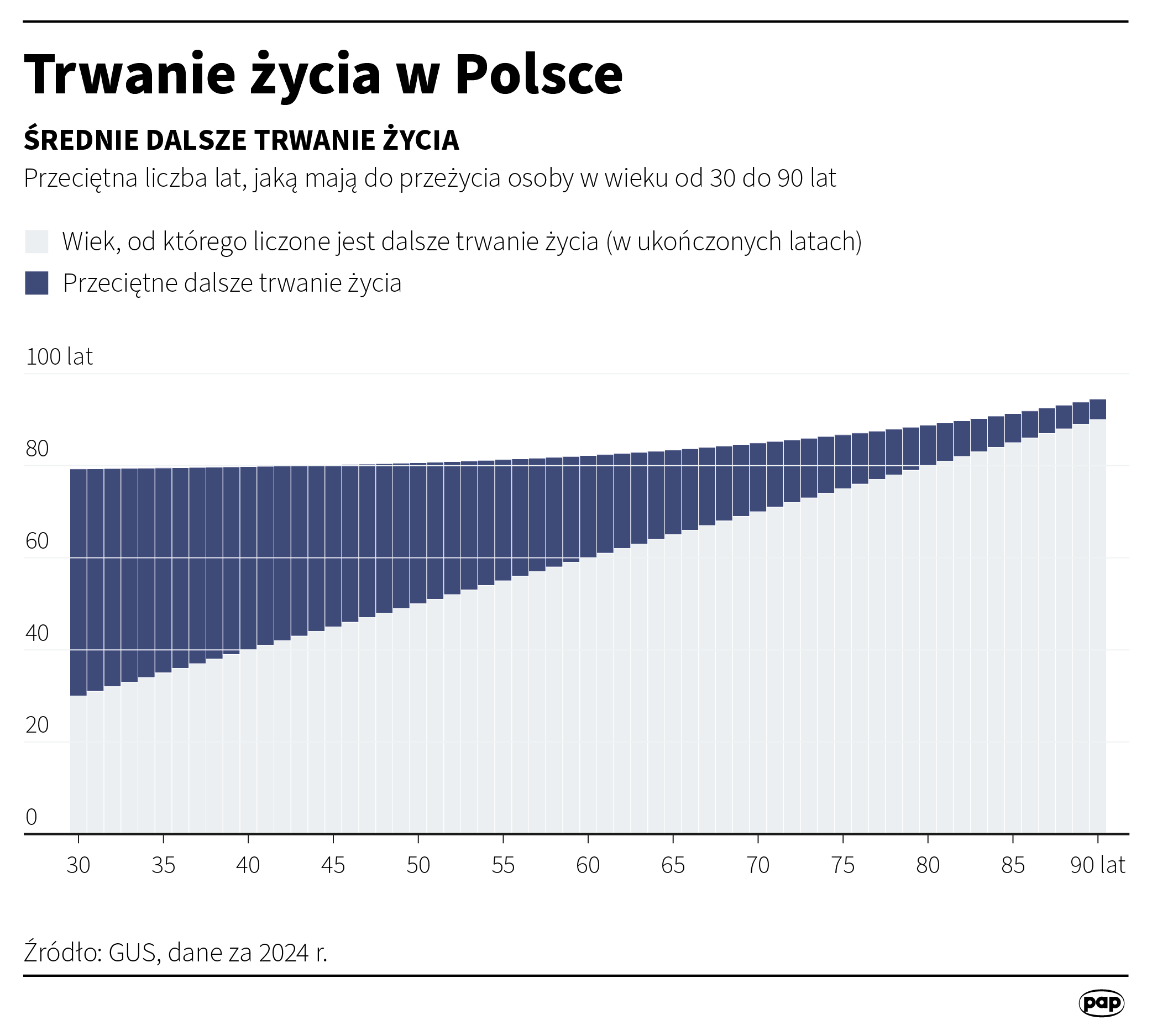Central Statistical Office: average life expectancy in Poland is at an all-time high; women live longer

In Poland, life expectancy is at an all-time high. In 2024, men lived an average of 74.93 years, while women lived 82.26 years, according to data from the Central Statistical Office. In Poland, the leading causes of death are circulatory system diseases, cancer, and respiratory diseases.
In a report published on Wednesday, the Central Statistical Office pointed out that average life expectancy is a key measure for assessing the health of the population, as well as a measure used to determine the amount of pensions.
Forecasts published by Eurostat and the UN, based on analysis of global changes, predict that average life expectancy will increase in most countries, including Poland. Similar results are presented in forecasts prepared by the Central Statistical Office.

The report notes that the increase in life expectancy observed in Poland over the past three decades has been abruptly halted as a consequence of the COVID-19 pandemic. Current life expectancy analysis indicates a reversal of the downward trend and a return to the pre-pandemic trend.
The Central Statistical Office (GUS) emphasized that life expectancy for both men and women in 2024 was the highest recorded in Polish history. Last year, the average life expectancy for men in Poland was 74.93 years, and for women, 82.26 years.
According to the report, life expectancy has increased by 0.3 years for men and women compared to 2023. Compared to 1990, life expectancy was 8.7 years and 7 years higher, respectively.
As noted by the Central Statistical Office (GUS), in Poland, as in other countries, the mortality rate among men is higher than among women and occurs in almost all age groups. Between 1985 and 2024, the mortality rate among men under 60 was approximately 2.6 times higher than among women of the same age. This proportion decreases after the age of 60.
The analysis also showed that male residents of Polish cities live longer on average than those living in rural areas. In the Masovian Voivodeship, this difference is the largest, at 2.2 years. For women, life expectancy is higher among rural residents in three macroregions, and in four, among urban residents. The largest difference is observed in the Masovian Voivodeship, with a difference of 1.1 years in favor of urban residents.
The Central Statistical Office noted that the largest difference in life expectancy between men and women was recorded in Wrocław (7.5 years). Compared to other large cities, the Katowice subregion and Łódź fare very poorly, with life expectancy being more than a year shorter than the national average.
In Poland, the leading causes of death are circulatory system diseases, cancer, and respiratory diseases. In 2023, they were responsible for approximately 71% of all deaths.
The report's authors noted that other phenomena are currently being observed that may contribute to a slowdown in life expectancy in Poland. The report notes that the significant increase in the number of obese people is alarming.
According to Eurostat data, in 2019 in Poland the percentage of people with BMI above the norm was 56.8 (Eurostat. European Health Interview Survey, 2019).
The report indicated that, according to the results of a collective analysis of representative studies of global trends in underweight and obesity from 1990 to 2023, the prevalence of obesity in Poland among women over the age of 20 in 2023 was 24.6% (an increase of 7.4 percentage points since 1990). For men, the figure was 32.2%, an increase of 20.8 percentage points compared to 1990.
Air pollution and the associated increase in the incidence of respiratory diseases, some cancers, and cardiovascular diseases may also be a significant factor. (PAP)
Science in Poland
kkr/ joz/
The PAP Foundation permits free reprinting of articles from the Nauka w Polsce website, provided that you notify us by email once a month of your use of the website and cite the source of the article. On portals and websites, please include the linked address: Source: naukawpolsce.pl, and in journals, please include the annotation: Source: Nauka w Polsce website - naukawpolsce.pl. This permission does not apply to information in the "World" category or any photographs or video materials.
naukawpolsce.pl





